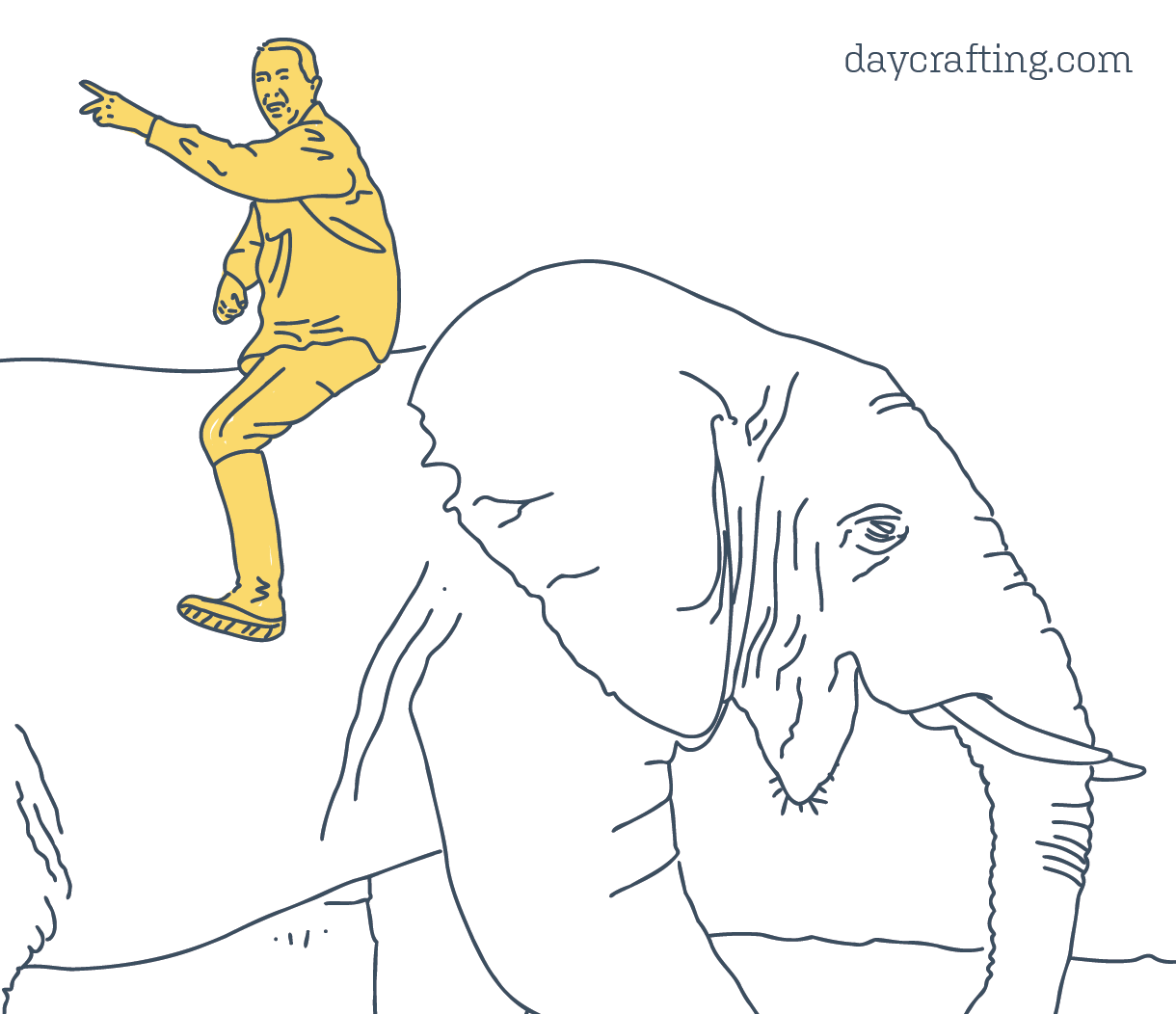The problem with business goals and imagining the future
Why is Day Crafting primarily concerned with shaping today, this day as the way to a good life? I began coaching leaders almost 20 years ago in the context of their skills development, quality of life and ambitions. I noticed that nearly everyone could easily imagine exciting future goals. I was part of a programme that took executives through a deep visioning process and at the end they knew this: where I want to be in x months or x years time. However, almost none of them knew how to affect the quality of the day they were actually in and most goals were dropped a matter of weeks later. The part of our thinking that imagines the future is no match for the identity and behaviour part that dominates the present.
Our thinking is sometimes conflicted in ways we are only sometimes aware of. Analogies provide a helpful way of describing these conflicts. In this case the elephant and rider represents our automatic vs controlled thinking.
Our well-developed automatic thinking, the elephant, has served us well and allows us to function efficiently in the present moment whilst assessing various risks simultaneously. Bolted on top of this highly evolved function is the relatively new module containing the controlled language and logic based thinking and future-planning functions, the rider.
The rider is very new, alpha-ware still in development. One bug in its software is that it thinks it is in charge but in a clash of wills, it is no match for the elephant: the efficient, present moment, highly evolved, automatic thinking part.
The problem with goals ... If I was to ask you where you want your life to be in a year's time, it will be the rider who answers. Your rider may be in total harmony with your elephant but if that isn't the case and the elephant doesn't share the goal, you're not going to achieve it.
Culture tells the wrong story about success.
Results have very little to do with the future goals set by the rider and nearly everything to do with the system of practice, in the present here-and-now that harnesses both elephant and rider. The elephant cares little for the future. Stories about innovation (goals achieved) excite the rider but they don’t tell us anything actionable. Instead we need to know how to get all of us to do innovating, the verb. This is a very different and less glamorous subject. The tasks ahead of us need to be designed to suit the craftsperson's daily routine. The craftsperson is someone working in the present moment with a degree of harmony between their thinking states. In developing Day Crafting, I'm trying to optimise productive, skilful practice in the scale of the day – which is the unit of measure that matters the most. I’ve been developing elephant training methods since identifying the coaching problems described above.Leading riders is harder work
Some leaders expect the future goal to provide motivation because we want to gloss over the present-moment steps to get there, which we instinctively know will be demanding, problematic or boring – and often they will be. I’ve worked for businesses where the most exciting description of the business appears only as a fantasy on the job adverts, written by riders to appeal to the applicant’s rider. The behavioural, now-focussed disciplines of the craftsperson are a different methodology and a distinct skill set. They enable a mindset switch from future goals to the working surface in the present. This is how adults flourish, grow and learn – but work needs to be configured to allow for this. By focusing on outcome-based goals that are outside of the control of most employees, we increase pressure, decrease confidence – and annoy elephants. For individuals as with businesses, solving problems at the results level risks a temporary fix (and no lasting wellbeing) but solving at the system-of-practice level opens the way to solid improvements on multiple fronts.From goal-drive to mission-drive
We expect people to give 100% every day. This is a challenging standard when focussed on future goals. It makes logical sense to our riders but doesn’t cut it with our elephants who see the future as being out of their hands. How might we work with the elephant and rider? Shifting from a goal-drive to a mission-drive works with the whole person in the present moment. Giving 100% to the mission, using the sources of energy that actually enliven a person and replenish quickly means they can repeat the same tomorrow. Customers prefer mission driven employees – people who are goal-driven have a much greater likelihood of being transactional. People who are mission-driven have a much greater likelihood of being transformational. Finally, for a business, Day Crafting helps towards one of the most important objectives: how can a team’s most important asset, its people, maximise their use of its scarcest resource, its time, to make sustainable meaningful progress? If you'd like to explore how, get in contact below.Written by Bruce Stanley on Fri, March 05, 2021
Please share this
Related posts
Redesigning rest and unlocking energy use
Given that the human brain is constantly monitoring our energy budget and predicting our energy use and attempting to get us to balance output with restoration, it is perverse, but not altogether out of character, that the part of our brain that thinks it runs the show should come up with a notion such as, 'I'll rest when I'm dead'. Sometimes we choose to believe the dumbest ideas.
